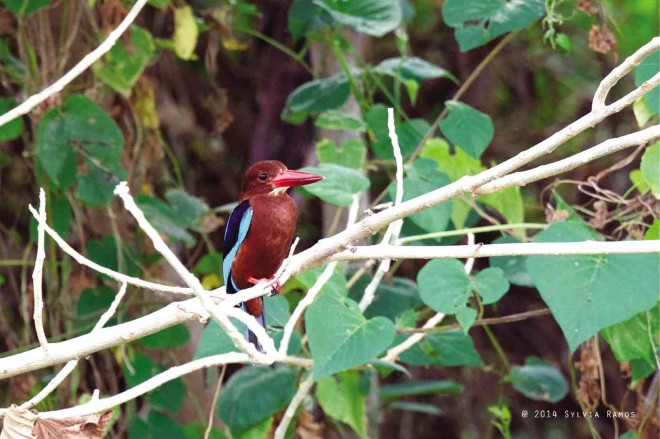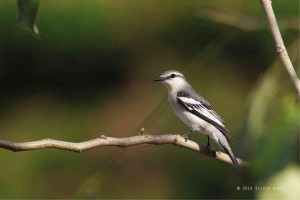Behind Munti condos, a treat for birding eyes

ROYALTY IN RESIDENCE The White-throated Kingfisher is just one of the 70 bird species documented by the Wild Bird Club of the Philippines in a “mini-forest” surprisingly thriving in the Ayala-Alabang area. SYLVIA RAMOS/CONTRIBUTOR
MANILA, Philippines —To celebrate Earth Month, wild bird photographers and environmental conservation advocates Sylvia and Tonji Ramos recently held a bird-watching walk for a small group of residents at Filinvest Corporate City in Muntinlupa City.
“We are always happy to share our love for birding with other people. It’s a fun and rewarding hobby,” Sylvia said. “People usually say they only see Eurasian Tree Sparrows (maya) in the city. I tell them there are other birds too—kingfishers, woodpeckers, sunbirds, flycatchers and more. They just haven’t seen them because their birding eyes have not yet been opened.”
“We have documented more than 70 bird species in Ayala Alabang alone,” she said. “It has made us realize that the simplest things such as planting the right trees or vines can make a place more bird-friendly. We want urban planners, real-estate developers and community members to be aware of this.”
The couple are members of the Wild Bird Club of the Philippines (WBCP), which was organized in July 2003 to promote bird watching to the general public and keep records of bird sightings in the country.
Since 2005, the WBCP has hosted annual bird festivals that offer guided tours and venues for information-sharing. The number of local and foreign participants from the east Asian region has grown steadily by the thousands through the years, making the festival one of the largest ecological projects in the country today.
Also joining the March 29 walk were retirees Imelda and Heinz Stumpf, who spend half of the year in Germany and half in the Philippines.
“My husband and I were very eager to join the bird-watching tour,” Imelda said. “We’ve seen many interesting birds when we go on our regular walks and we were curious to know their names. It is the first outdoor activity we have joined and it’s suitable for senior citizens like us since the sports and social events held in the area are extremely noisy and cater only to more physically active groups.”
In Germany, she noted, there are strict regulations protecting both wildlife and communities from being disturbed by loud music and construction noise.
As she spoke, an olive-brown flyer darted over a nearby house. “Isn’t that the bird we often hear singing on our morning walks?” she asked her husband, who hurriedly adjusted his binoculars to see the bird more clearly.
Stream offers haven
“That’s a Yellow-vented Bulbul,” Sylvia said. “It’s a resident bird that breeds in the Philippines and is found here year round.”
“We’ll see more birds at the water source,” she added, pointing to an undeveloped area with a running stream behind several condominiums, where the vegetation had largely remained untouched.

THE SIGHT of a Pied Triller rewards participants in a recent bird-watching tour in Muntinlupa City. SYLVIA RAMOS/CONTRIBUTOR
As Sylvia promised, the “mini-forest” behind the condos revealed a Barred Rail, a White-breasted Waterhen and a White-throated Kingfisher, perched either on the fallen branches or on the rocks by the grassy banks. The Kingfisher was hard to miss even from a distance, thanks to the bright blue spot on its plumage.
“There’s also a Little Egret, with its black legs and yellow feet, standing motionless in the water. It must be waiting for a fish,” adds Tonji, almost in a whisper, as he looked through his binoculars. “This stream is a great habitat for birds, some of them here to hunt for insects while others eat the fruits of the ficus trees along the banks.”
Nonstop sightings
The sightings continued: “Those are Black Crown Night Herons. The ones colored black, white and grey are the adults and the brown ones with white markings are their young.”
And then some more: “Those birds near the water are Yellow Bitterns, Cinnamon Bitterns, Barred Rails and White-breasted Waterhens. They like to hunt for food around the edges of the water and near the tall grass.”
Cut the grass and you rob species like Grass Owls of their habitat, he explained.
Still, most of the “migrants” prefer the tree tops, like Brown Shrikes, Grey Wagtails and Arctic Warblers. The last are insectivores who visit the Philippines from August to May. Drive them out and you lose a major partner in controlling the insect population, Sylvia added.
Another group of 12 birds resting in a tree caught Tonji’s attention. “Those are Chestnut-cheeked Starlings. It’s the first time we’ve seen them in the area. We’ve seen them flying north from Laguna province in big numbers, so this may have been a good pit stop. They’re probably moving north to breeding grounds in Japan and Russia.”
The Ramoses have made it their calling to educate children and adults about endemic birds and environmental conservation.
Every year, schoolchildren visit the WBCP bird fair. Sylvia sadly noted, however, that while they could easily identify swans, flamingoes, penguins and other foreign birds because of the western shows or cartoons they watch, they could name only the maya and the Philippine Eagle among the 673 local species.
“There is a lack of information dissemination and environmental awareness in many of our schools. On one occasion, we were at La Mesa EcoPark waiting quietly to photograph a bird, when a school bus full of students arrived and they began running under the trees. They were laughing, shouting, trampling on tree saplings and pulling at plants. The reason? Their teacher made a game of gathering different leaves with no clear educational purpose, not bothering to identify the trees they came from.”
Wild but ‘proper’
People need to observe “proper behavior” when in the wild, whether it’s for bird watching, taking pictures or participating in an outdoor event, Tonji said. “Treat the habitat with respect; don’t leave your trash, destroy the plants and disturb the wildlife. The old adage of ‘take nothing but pictures’ applies to any site.”
“If you play loud music or speak loudly, you don’t get to hear the sounds of nature,” he stressed. “With a lot of sporting events now being held in mountains and (nature) trails, participants and organizers shouldn’t use loudspeakers, for example. It signifies a higher level of learning and a higher class of event if they realize that biking or running through nature is about bonding with it rather than driving it away.”
Groups interested in taking a bird-watching tour in Filinvest City are advised to secure permission from the management.